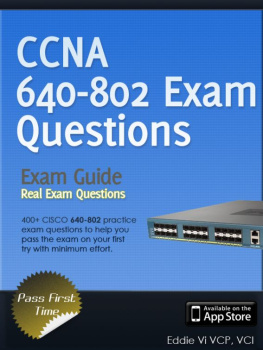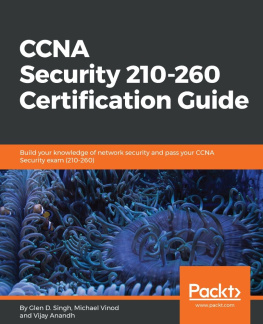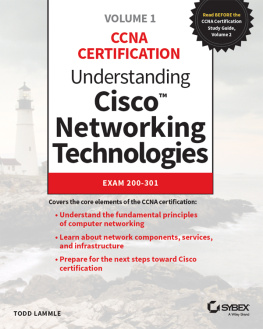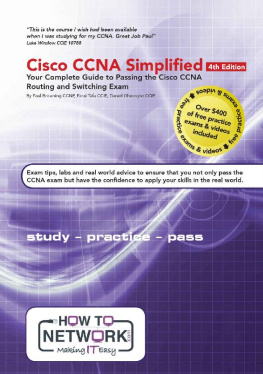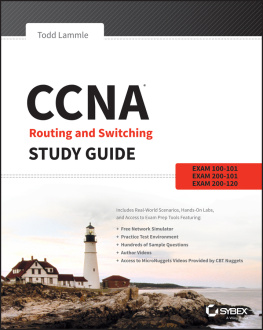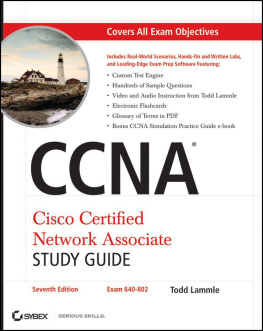640-802CCNA
By
Eddie Vi
SMASHWORDS EDITION
PUBLISHED BY:
E Vi on Smashwords
Copyright 2012 EVii
This ebook islicensed for your personal enjoyment only. This ebook may not bere-sold or given away to other people. If you would like to sharethis book with another person, please purchase an additional copyfor each recipient. If youre reading this book and did notpurchase it, or it was not purchased for your use only, then pleasereturn to Smashwords.com and purchase your own copy. Thank you forrespecting the hard work of this author.
Contents
Introduction
This book includes newsample questions never before in print. Offering numerous samplequestions available nowhere else, this book will help you pass the640-802 CCNA exam on your first attempt.
The 640-802 CiscoCertified Network Associate (CCNA) is the composite exam associatedwith the Cisco Certified Network Associate certification.Candidates can prepare for this exam by taking the InterconnectingCisco Networking Devices Part 1 (ICND1) v1.0 and theInterconnecting Cisco Networking Devices Part 2 (ICND2) v1.0courses. This exam tests a candidate's knowledge and skillsrequired to install, operate, and troubleshoot a small to mediumsize enterprise branch network. The topics include connecting to aWAN; implementing network security; network types; network media;routing and switching fundamentals; the TCP/IP and OSI models; IPaddressing; WAN technologies; operating and configuring IOSdevices; extending switched networks with VLANs; determining IProutes; managing IP traffic with access lists; establishingpoint-to-point connections; and establishing Frame Relayconnections.
The following topicsare general guidelines for the content likely to be included on theCisco Certified Network Associate exam. However, other relatedtopics may also appear on any specific delivery of the exam
Describe how anetwork works
Configure, verify and troubleshoot a switch with VLANs andinterswitch communications
Implement an IP addressing scheme and IP Services to meet networkrequirements in a medium-size Enterprise branch officenetwork.
Configure, verify, and troubleshoot basic router operation androuting on Cisco devices
Explain and select the appropriate administrative tasks requiredfor a WLAN
Identify security threats to a network and describe general methodsto mitigate those threats
Implement, verify, and troubleshoot NAT and ACLs in a medium-sizeEnterprise branch office network.
Implement and verify WAN links
Questions
Question 1
As a networkadministrator, you will need to decide on the appropriate networkdevices to use. Which of the following correctly describes theroles of devices in a WAN? (Choose three)
A. A modem terminates a digital local loop.
B. A CSU/DSU terminates a digital local loop.
C. A CSU/DSU terminates an analog local loop.
D. A modem terminates an analog local loop.
E. A router is commonly considered a DTE device.
A. ABC
B. BCE
C. BDE
D. ADE
Answer: C
Summary
Not too much tosay here except CSU/DSU is considered to be a DCE
Question 2
Which of thefollowing statements are true regarding bridges and switches?(Choose 3.)
A. Both bridges and switches make forwarding decisions based onLayer 2 addresses.
B. Switches have a higher number of ports than most bridges.
C. Switches are primarily software based while bridges are hardwarebased.
D. Both bridges and switches forward Layer 2 broadcasts.
E. Bridges define broadcast domains while switches define collisiondomains.
F. Bridges are frequently faster than switches.
A. ABD
B. ABC
C. ABD
D. ADE
Answer: A
Question 3
It is known thatthe OSI model has seven layers. Can you tell me at which layers ofthe OSI model WANs operate? (Choose two.)
A. session layer
B. datalink layer
C. transport layer
D. physical layer
A. AD
B. BD
C. CD
D. AC
Answer: B
Question 4
How does replacinga hub with a switch affect CSMA/CD behavior in an Ethernetnetwork?
A. In increasesthe size of the collision domain by allowing more devices to beconnected at once.
B. It effectively eliminates collisions.
C. It reduces the total amount of bandwidth available to eachdevice.
D. It decreases the amount of time that a jam signal must be sentto reach all network devices.
Answer: B
Question 5
Why will a switchnever learn a broadcast address?
A. Broadcasts onlyuse network layer addressing.
B. Broadcast addresses use an incorrect format for the switchingtable.
C. A broadcast address will never be the source address of aframe.
D. Broadcast frames are never sent to switches.
Answer: C
Question 6
Which two of thesestatements regarding RSTP are correct? (Choose two.)
A. RSTP defines new port roles.
B. RSTP is compatible with the original IEEE 802.1D STP.
C. RSTP defines no new port states.
D. RSTP cannot operate with PVST+.
A. AB
B. AC
C. AD
D. CD
Answer: A
Question 7
Which twofunctions of switch ports will forward traffic on the basis of theIEEE 802.1w standard? (Choose two.)
A. alternate
B. backup
C. designated
D. root
A. AD
B. BD
C. CD
D. BC
Answer: C
Question 8
Which of thefollowing describe private IP addresses? (Choose two.)
A. addresses licensed to enterprises or ISPs by an Internetregistry organization
B. addresses that can be routed through the public Internet
C. a scheme to conserve public addresses
D. addresses that cannot be routed through the publicInternet
E. addresses chosen by a company to communicate with theInternet
A. AD
B. AB
C. BC
D. CD
Answer: D
Question 9
Which twoaddresses can be assigned to a host with a subnet mask of255.255.254.0? (Choose two.)
A. 113.10.4.0
B. 186.54.3.0
C. 175.33.3.255
D. 26.35.2.255
E. 17.35.36.0
A. AB
B. BD
C. AD
D. CD
Answer: B
Question 10
In theimplementation of VLSM techniques on a network using a single ClassC IP address, which subnet mask is the most efficient forpoint-to-point serial links?
A.255.255.255.240
B. 255.255.255.254
C. 255.255.255.0
D. 255.255.255.252
Answer: D
Question 11
Which two of thesestatements are true of IPV6 address representation? (Choosetwo)
A. A single interface may be assigned multiple IPV6 addresses ofany type
B. Every IPV6 interface contains at least one loopbackaddress.
C. Leading zeros in an IPV6 16 bit hexadecimal field aremandatory.
D. The first 64 bits represent the dynamically created interfaceID
A. AB
B. AC
C. BC
D. CD
Answer: A
Summary
the loopbackaddress is ::1/128
Global Unicast addresses start with 2000::/3 and are assigned bythe IANA
Link Local Starts with FE80::/10 1111 1110 10
Every IPv6 interface contains at least one Link Local address &the Loopback address
Question 12
What will a newrouter do during startup if a configuration file is not located inNVRAM?
A. It will searchfor the configuration file in flash and if no configuration file isfound there, it will enter the setup dialog.
B. It will search for the configuration file on a TFTP server andif no configuration file is found there, it will load a limitedconfiguration file fromROM.
C. It will search for the configuration file on a TFTP server andif no configuration file is found there, it will enter the setupdialog.
D. It will search for the configuration file in flash and if noconfiguration file is found there, it will load a limitedconfiguration file from ROM.
Answer: C
Question 13
The RoutingInformation Protocol (RIP) is a dynamic routing protocol used inlocal area networks. What is the default routing update period forRIPv2?

